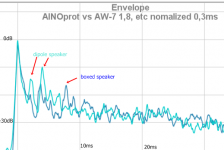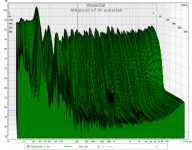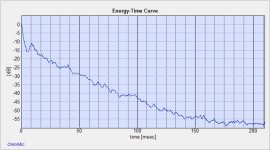Jeez, it is really difficult to draw conclusions of this. What is the speaker and what is the room?
Typically, less than the first millisecond is the speaker itself. The rest is room decay and noise.
When you see the ETC "flatten out" at a stead-state level, its background noise you are measuring. You need to measure at a very high SPL (at least 90 dB) to get the real room decay with any accuracy.
And for a reference, a coaxial 2-way closed box speaker at same position and distance as AINOproto
Notice the difference to the dipole speaker! Does this refer to "precision an good transients" that dipoles are said to have?
It looks like your dipole radiates much less energy into the room for the same SPL at the listening position, of course resulting in lower level of all reflections. This is not a surprise, and it is one of the reasons dipoles usually sounds more accurate.
OK so here is my first crack at doing an etc curve. Not sure (1) if I did it correctly and (2) if the results are good. bad, or need to redo.
Like Markus already said: Try to spread the measurement to the first 20 ms only with a vertical resolution of 30 dB. Most graphs that extend much over 50 ms will look "nice", but the first ~10 ms are more important.graphs show measurements before and after room treatment. ETC and EDT
Jimbones, your etc looks good to me! It's hard to do any better.
This is what an ETC typically looks like in a non-treated living room. This level of early reflection sounds very bad.
An externally hosted image should be here but it was not working when we last tested it.
I'd say the first 20-30 ms is important. Any strong reflections in that time windows will be audible.
I agree but most rooms are so small, important first reflections happen within 10ms. In the end it depends on room size and what one is interested in. Imaging problems happen within the first 2ms, first reflections within about 20ms, echos at 20ms and higher, overall decay develops over several hundred ms. The latter should be examined in frequency bands.
Here's an other set of ETC's of a non-treated room, 5 x 7.5 x 3 meters (my own room).
As we can see the early reflections are strong, then comes the build-up of room decay, and the real decay does not start until after ~80 ms.
As we can see the early reflections are strong, then comes the build-up of room decay, and the real decay does not start until after ~80 ms.
An externally hosted image should be here but it was not working when we last tested it.
An externally hosted image should be here but it was not working when we last tested it.
Here is a close-up of my overlays
Seems like the dipole excites more peaks during first 10ms!
Here is my decay waterfall, we can see strong decay at 42, 80, ~200, 600 and 800Hz
My AINO dipoles are in pieces now, but I'll take them out for "anechoid" messurements perhaps next week!
Seems like the dipole excites more peaks during first 10ms!
Here is my decay waterfall, we can see strong decay at 42, 80, ~200, 600 and 800Hz
My AINO dipoles are in pieces now, but I'll take them out for "anechoid" messurements perhaps next week!
Attachments
Louder and more spread out
Ahh yes, I was not at that spl level I can confirm. I'll play it louder and spread the measurement out like you say and I'll report tomorrow. Thanks.
Like Markus already said: Try to spread the measurement to the first 20 ms only with a vertical resolution of 30 dB. Most graphs that extend much over 50 ms will look "nice", but the first ~10 ms are more important.
Ahh yes, I was not at that spl level I can confirm. I'll play it louder and spread the measurement out like you say and I'll report tomorrow. Thanks.
There is no need to play it real loud.Ahh yes, I was not at that spl level I can confirm. I'll play it louder ...
With most programs you can rescale the graph. That would be sufficient.... and spread the measurement out like you say and I'll report tomorrow.
Rudolf
Rudolf, markus76 and StigErik,
thank you for your very helpful and informative guidance!
I want this thread to help people to understand acoustic measurements and to improve their systems. I have been studying these things intensively for 7-8 years at several websites and forums as a hobby and I learn something every day I put my head here!
thank you for your very helpful and informative guidance!
I want this thread to help people to understand acoustic measurements and to improve their systems. I have been studying these things intensively for 7-8 years at several websites and forums as a hobby and I learn something every day I put my head here!
Last edited:
I'd for for absorptive anyway, regardless of the distance between speakers and front wall.
Yes - that means killing off the rear radiation.
Really?
What is to be gained from this, accuracy vs spaciousness? In that case wouldn't it be a subjective trade off?
Were the RFZ and LEDE designs created for the accurate rendition of real or synthetic sound sources? Are these designs the last word for any type of musical genre? Is 100 or 200ms the best RT for all type of music?
Also, a dead room begs for more sound power so increases chances for distorsion and raises costs on all fronts, treatment, amplifiers, speakers and so on..
I would also tend to think that the natural reverberation in the recording should come from everywhere in the room and not only from two single points in space at 60°, a highly unatural thing. Adding diffusers on the back does not seem to compensate enough for stereo limitations.
When the rear wave of a dipole is canceled, the sound turns more like a nearfield omni, more precise but will less depth and if far from boundaries sound sources become points in space. Very useful for monitoring probably, but for pure enjoyement maybe less so..
When I see how deep and thorough the research for Hall Design is, I cannot stop thinking that there is more to do with our rooms and speakers to attain realism than absorbing everything, unless we only listen to synthetic sources.
Two well-known links regarding stereo and rooms limitations:
Ambiophonics 2nd Edition - Chapter 2
Ambiophonics 2nd Edition - Chapter 1
And another with some interesting comments on small halls acoustics, see sides 8,9,10,15, 38, 63.
http://www.chrgsummerinstitute.com/Russ%20Altermatt%20-%20Listener%20Envelopment.pdf
Yoichi Ando suggested that the time delay of the strongest reflection is
more important than the first reflection
and:
The amount of “early lateral sound” energy does not seem to be a
issue.Too much “total early sound” energy may be an issue, especially wherelarge music groups are involved in smaller music halls
I recently bought a book by Ando, Architectural Acoustics, it has been very useful with some very interesting figures, for ex this one:
An externally hosted image should be here but it was not working when we last tested it.
I think we rather need to know more about the role of reflexions, and the way we could use them to our benefit. For example, according to the above graph, the rear wave of a dipole, associated with the right acoustic treatment angled optimally could increase spatiousness whilst keeping the sound power.
Not an easy task to achieve, for sure, but maybe well worth it?
Last edited:
Since there are no established standards for music playback (like there is for movie theaters), we can choose for ourselves what we like of course. Music is not mixed or recorded with a specific playback acoustic in mind.
My personal goal is to have the accuracy and definition of high-end headphones, but with a soundstage not possible to achieve with headphones. That approach requires a very dead room and short listening distance.
When I occasionally listen to other setups in more lively rooms, I do understand why this is preferred by some. There is more volume, impact and spaciousness, but at the cost of definition, dynamics, clarity and what I call "blackness" - meaning total silence where there should be no sound.
My personal goal is to have the accuracy and definition of high-end headphones, but with a soundstage not possible to achieve with headphones. That approach requires a very dead room and short listening distance.
When I occasionally listen to other setups in more lively rooms, I do understand why this is preferred by some. There is more volume, impact and spaciousness, but at the cost of definition, dynamics, clarity and what I call "blackness" - meaning total silence where there should be no sound.
Nor sure what you mean by "canceled" but my direct experience has been that when the back wave is not reflected, depth is greatly enhanced. There is a loss of energy at the low end, tho.When the rear wave of a dipole is canceled, the sound turns more like a nearfield omni, more precise but will less depth and if far from boundaries sound sources become points in space.
StigErik described well two very different preferences and environments. I am lucky to have two very different sounding rooms/setups at home, because my preference is not constant! Both of them can reproduce 2.0, 2.1 or 2.3 and 5.1 or 5.2. For movies and "hifi-solo" listening I prefer the smaller and less reflective room. The bigger room is ok for watching tv/movies and background music.
My personal goal is to have the accuracy and definition of high-end headphones, but with a soundstage not possible to achieve with headphones. That approach requires a very dead room and short listening distance.
Why is short distance a requirement?
When I occasionally listen to other setups in more lively rooms, I do understand why this is preferred by some. There is more volume, impact and spaciousness, but at the cost of definition, dynamics, clarity and what I call "blackness" - meaning total silence where there should be no sound.
I haven't given up on the idea that both can be had at the same time but all my experiments so far suggest that spaciousness and (spatial) detail are mutually exclusive.
Did you experiment with panels that create a defined lateral (height) reflection in order to bring back some spaciousness in your setup?
Short listening distance will bring down the reflection level. The shorter the distance, the more direct sound so to speak.
I have experimented with diffusors to create exactly what you describe, to get "spaciousness". It did, but it did not like it. I prefer the "blackness" of a direct sound.
I have experimented with diffusors to create exactly what you describe, to get "spaciousness". It did, but it did not like it. I prefer the "blackness" of a direct sound.
Short listening distance will bring down the reflection level. The shorter the distance, the more direct sound so to speak.
So short distance is not a requirement but the decreased reflection level coming with it.
I personally find it very distracting when speakers are very close because the auditory scene moves equally close.
I have experimented with diffusors to create exactly what you describe, to get "spaciousness". It did, but it did not like it. I prefer the "blackness" of a direct sound.
I was not talking about a diffusor but a rigid panel causing a very strong single reflection.
- Status
- This old topic is closed. If you want to reopen this topic, contact a moderator using the "Report Post" button.
- Home
- General Interest
- Room Acoustics & Mods
- OB speakers and room acoustics


